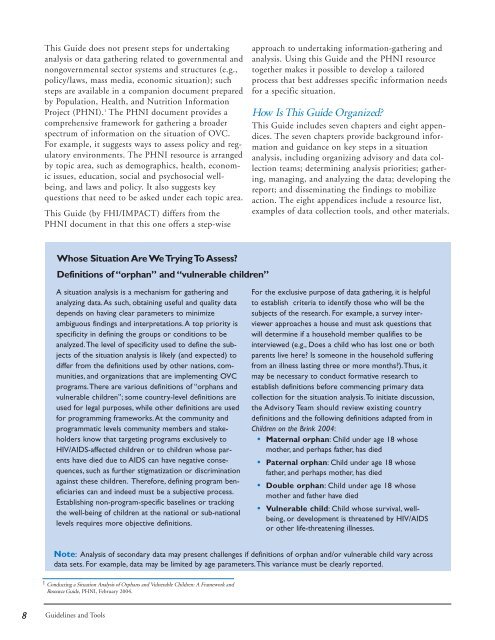Conducting a Participatory Situation Analysis of.pdf - Global HIV ...
Conducting a Participatory Situation Analysis of.pdf - Global HIV ...
Conducting a Participatory Situation Analysis of.pdf - Global HIV ...
You also want an ePaper? Increase the reach of your titles
YUMPU automatically turns print PDFs into web optimized ePapers that Google loves.
This Guide does not present steps for undertaking<br />
analysis or data gathering related to governmental and<br />
nongovernmental sector systems and structures (e.g.,<br />
policy/laws, mass media, economic situation); such<br />
steps are available in a companion document prepared<br />
by Population, Health, and Nutrition Information<br />
Project (PHNI). 1 The PHNI document provides a<br />
comprehensive framework for gathering a broader<br />
spectrum <strong>of</strong> information on the situation <strong>of</strong> OVC.<br />
For example, it suggests ways to assess policy and regulatory<br />
environments. The PHNI resource is arranged<br />
by topic area, such as demographics, health, economic<br />
issues, education, social and psychosocial wellbeing,<br />
and laws and policy. It also suggests key<br />
questions that need to be asked under each topic area.<br />
This Guide (by FHI/IMPACT) differs from the<br />
PHNI document in that this one <strong>of</strong>fers a step-wise<br />
approach to undertaking information-gathering and<br />
analysis. Using this Guide and the PHNI resource<br />
together makes it possible to develop a tailored<br />
process that best addresses specific information needs<br />
for a specific situation.<br />
How Is This Guide Organized?<br />
This Guide includes seven chapters and eight appendices.<br />
The seven chapters provide background information<br />
and guidance on key steps in a situation<br />
analysis, including organizing advisory and data collection<br />
teams; determining analysis priorities; gathering,<br />
managing, and analyzing the data; developing the<br />
report; and disseminating the findings to mobilize<br />
action. The eight appendices include a resource list,<br />
examples <strong>of</strong> data collection tools, and other materials.<br />
Whose <strong>Situation</strong> Are We Trying To Assess?<br />
Definitions <strong>of</strong> “orphan” and “vulnerable children”<br />
A situation analysis is a mechanism for gathering and<br />
analyzing data.As such, obtaining useful and quality data<br />
depends on having clear parameters to minimize<br />
ambiguous findings and interpretations.A top priority is<br />
specificity in defining the groups or conditions to be<br />
analyzed.The level <strong>of</strong> specificity used to define the subjects<br />
<strong>of</strong> the situation analysis is likely (and expected) to<br />
differ from the definitions used by other nations, communities,<br />
and organizations that are implementing OVC<br />
programs.There are various definitions <strong>of</strong> “orphans and<br />
vulnerable children”; some country-level definitions are<br />
used for legal purposes, while other definitions are used<br />
for programming frameworks.At the community and<br />
programmatic levels community members and stakeholders<br />
know that targeting programs exclusively to<br />
<strong>HIV</strong>/AIDS-affected children or to children whose parents<br />
have died due to AIDS can have negative consequences,<br />
such as further stigmatization or discrimination<br />
against these children. Therefore, defining program beneficiaries<br />
can and indeed must be a subjective process.<br />
Establishing non-program-specific baselines or tracking<br />
the well-being <strong>of</strong> children at the national or sub-national<br />
levels requires more objective definitions.<br />
For the exclusive purpose <strong>of</strong> data gathering, it is helpful<br />
to establish criteria to identify those who will be the<br />
subjects <strong>of</strong> the research. For example, a survey interviewer<br />
approaches a house and must ask questions that<br />
will determine if a household member qualifies to be<br />
interviewed (e.g., Does a child who has lost one or both<br />
parents live here? Is someone in the household suffering<br />
from an illness lasting three or more months?).Thus, it<br />
may be necessary to conduct formative research to<br />
establish definitions before commencing primary data<br />
collection for the situation analysis.To initiate discussion,<br />
the Advisory Team should review existing country<br />
definitions and the following definitions adapted from in<br />
Children on the Brink 2004:<br />
• Maternal orphan: Child under age 18 whose<br />
mother, and perhaps father, has died<br />
• Paternal orphan: Child under age 18 whose<br />
father, and perhaps mother, has died<br />
• Double orphan: Child under age 18 whose<br />
mother and father have died<br />
• Vulnerable child: Child whose survival, wellbeing,<br />
or development is threatened by <strong>HIV</strong>/AIDS<br />
or other life-threatening illnesses.<br />
Note: <strong>Analysis</strong> <strong>of</strong> secondary data may present challenges if definitions <strong>of</strong> orphan and/or vulnerable child vary across<br />
data sets. For example, data may be limited by age parameters.This variance must be clearly reported.<br />
1 <strong>Conducting</strong> a <strong>Situation</strong> <strong>Analysis</strong> <strong>of</strong> Orphans and Vulnerable Children: A Framework and<br />
Resource Guide, PHNI, February 2004.<br />
8<br />
Guidelines and Tools















